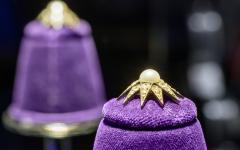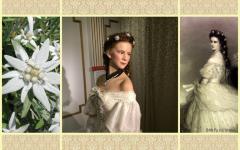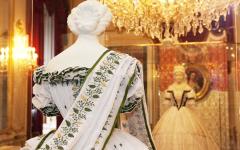CASTLE OF DREAMS
The Hermes Villa, Vienna
The Hermes Villa in the Lainz Game Reserve is the Wien Museum's largest branch location and a place of remembrance of Empress Elisabeth of Austria. In the summer of 1881, Emperor Franz Joseph decided to have a residence built for his wife, Elisabeth in the Lainz Game Reserve. The area of the reserve is in Vienna, not far from Schönbrunn Palace, the summer residence of the Habsburgs. Franz Joseph knew how much Sisi did not like to stay in the two official residences of Vienna, either in Hofburg or Schönbrunn. Instead, from the early 1860s, she spent more and more time with travelling outside Austria and not only inside the border of the Austro-Hungarian Monarchy. With building the villa, the Emperor’s intention was to urge his wife to spend more time in the Imperial city as well as with him. He wished to spend his old age with her in the Lainz Villa. He wrote to Sisi about his intention in a letter and she was glad about it.
Baron Franz Nopcsa, the chamberlain (in other word, steward) of Elisabeth’s household, was commissioned by presenting various plans drafted about the Villa for the Imperial couple to choose from. Nopcsa was involved in the whole project as an advisor in many matters. One of the favourite architects of the Emperor, Carl von Hasenauer (1833-1894), who had designed several important buildings in the Ringstrasse, drafted plans for the house. At the time, the future residence was usually referred to as “Villa Waldruh”, which meant something like “peace in the forest”. When the constructing works started, no one suspected that Elisabeth would give up horse riding in 1882, and that was why so many stables were provided as well as a manège (circus floor).
Hermes Villa / photo by Hertha Hurnaus © Wien Museum
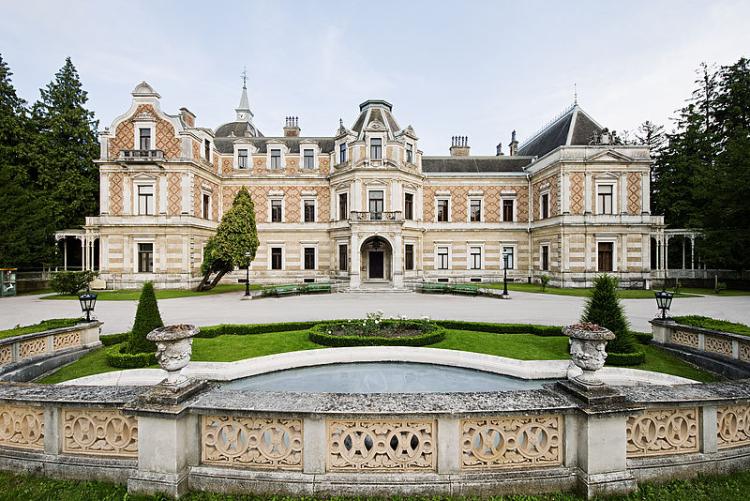
Construction work started in 1882, and along with the interior decorations, they were completed in 1886. Back then, on 9 January 1884, the Emperor wrote a handwritten document which stated that he gave the building and the 36 hectares game reserve around it to the Empress. The contract stating Elisabeth’s ownership of the area was officially signed on 20 March. In May 1887, Elisabeth, who was nearly 50 years old then, could live in what she would call her "'palace of dreams" in one of her poems.
The building took its name from the statue of Hermes, God of travels, created by the sculptor Ernst Herter and placed in the garden, in front of the main entrance to the building. The sculptor, Herter was commissioned by Empress Elisabeth to carve the statue of Hermes in 1885, and around this time the Villa started to be called (and referred to as) “Hermes Villa” instead of Lainz Villa or “Villa Waldruh”. The statue was finished in 1888. I guess the fact that Elisabeth named the palace (which was built in order to keep her in Vienna) after the God of travels does not need any further explanation…
Sisi visited Hermes Villa first in May 1886 and from that year in each spring and in the beginning of each summer she spent a few weeks there. She was there for the last time in the year of her death, 1898, when she moved to the building in early May and stayed there until mid-June. The villa was in the forest, which ensured some solitude. A deer park was around the building and the whole huge place was surrounded and protected by bodyguards, so it was free from outsiders. Elisabeth could enjoy the nature freely: walking in the forest for hours, swimming in the lake, writing poems and spending time in the nature. This was not built for representation. Here there were no apartments from neither any of her ladies-in-waiting, nor her confidence and friend, Ida Ferenczy. The building was provided with all the modern conveniences and innovations, of course, including a bathroom for the Empress.
Hermes Villa with the Hermes Statue (photo by Barbara Káli-Rozmis)
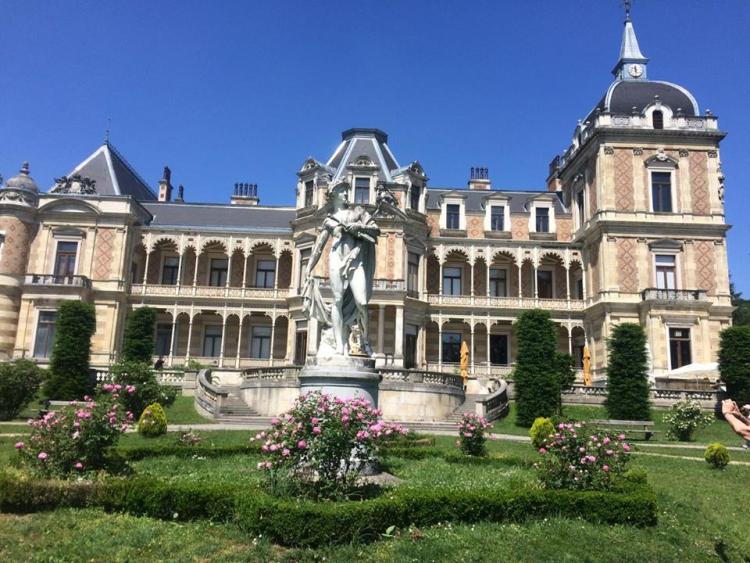
Elisabeth also loved the spiral staircase in her apartment (on the first floor) on which she could leave the villa unnoticed and be in the forest in no time, which surrounded the whole building. Elisabeth often went swimming in the large pond of the Lainz Game Reserve, not far from the villa. As mentioned above, she had given up horse riding and fencing but as every place she stayed also in Hermes Villa, she had a gymnastics room (in Pompei-style) for her daily workout complete with balance beam, climbing poles, rings and a scale to check her weight. After giving up horse riding, she took up a new sport: fast walking and hiking. It was demanding not only for her company (ladies-in-waiting etc.) but also for the secret police of the countries she was staying. Elisabeth was not always aware of the fact that she was observed and followed by guards, if so, she tried everything to get rid of her secret followers. There were only a few people who were able to keep up with her. The Hermes Villa’s idyllic surroundings were suitable for her to enjoy nature undisturbed.
Elisabeth’s gymnastic room in Hermes Villa. The wall paintings of that room were made by August Eisenmenger, Hugo Charlemont and Adolf Falkenstein imitate models from Pompei. Photo by Hertha Hurnaus © Wien Museum
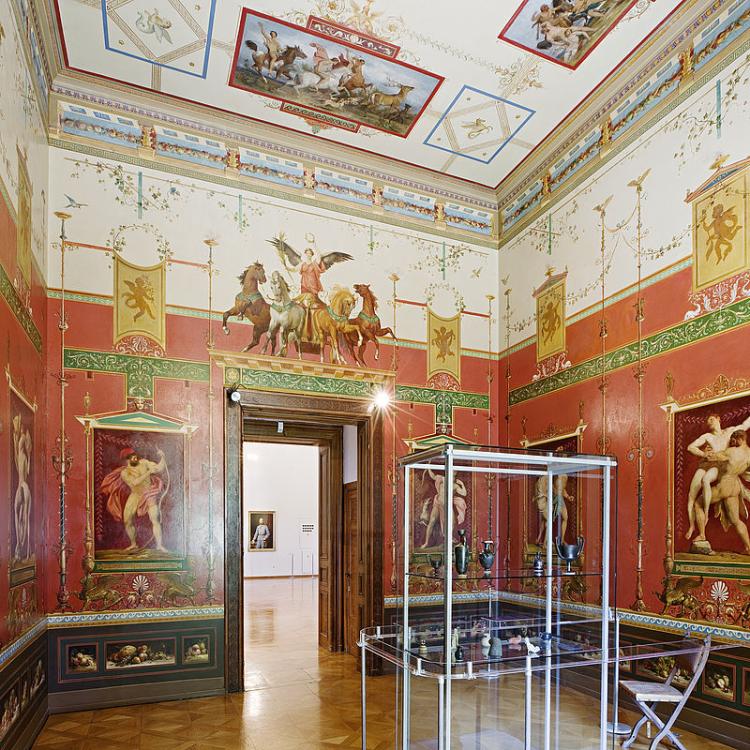
Franz Joseph tried to do everything to please his wife, however, the smallest child, Marie Valerie wrote about the Hermes Villa in her diary: “Mama’s rooms have the best will in the world to be enormously friendly, but I detest their mannered rococo!” Furthermore, she also noted that “actually uninvitingly handsome and modern, and it is not at all like us and what we have been used to so far.” Franz Joseph was disappointed and said the following: “I shall always be afraid that I will spoil everything.” (Hamann, 280)
Elisabeth enjoyed the days spent in Hermes Villa, even if she usually stayed there only a few weeks each year. She wrote the following poem on her arrival at the villa in the evening of 16 May 1877. The poem is written now on the wall inside the building remembering her. Her lines are also quoted in the book of the exhibition: Wien Museum – Hermesvilla. Sisi’s Castle of Dreams. Elisabeth’s poem in three verses, each consists of four lines:
“Again the evening silent creeps; / Shadows now begin to lengthen, / Darkness falls and will yet strengthen, / Entombed by night the day shall sleep.
Forest dark – ‘midst branches twining / Moons appear to rise on high; / With their pale light to show the way, / Down on this green labyrinth shining.
But now open up the trees, / Curving semi-circular round; / Moonlight-frosted, on the ground / Gleams Titania’s castle of dreams.”
Elisabeth's bedroom at Hermes Villa / photo by Hertha Hurnaus © Wien Museum
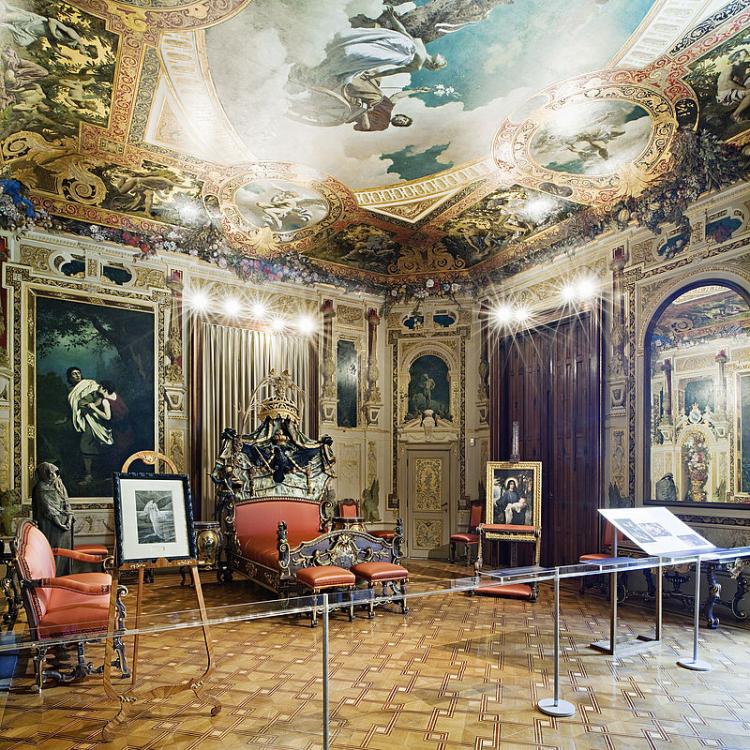
The children of Elisabeth and Franz Joseph at Hermes Villa
Rudolf, the crown prince (1858-1889)
Rudolf did not often visit the palace during his life since he died in a few year after it had been constructed. (He died on 30 January 1889.) Following his death his widow, Stephanie was invited in May and in June in 1889, the second time she visited the palace with Elisabeth (Erzsi – 1883-1963), Rudolf’s only-child. Marie Valerie wrote in her diary after this occasion: “During all this Mama asks the little girl if she can still remember Christmas, when her dear good Papa (Rudolf) was still with us, if she ever still thinks of her dear Papa? She looked at us in alarm with her great blue eyes and whispered: ‘Yes’, but then immediately began to talk of something else.” (Hermes Villa, 35)
Gisela (1856-1932)
Gisela had already been married when the villa was built. She, the oldest daughter of the Imperial couple got married in 1873. The first time Gisela stayed at the villa was in 1888. On of her daughters, Augusta got engaged to Archduke Joseph August here in May 1893. Gisela and her family also got a wing at the villa.
Marie Valerie (1868-1924)
As it turned out from her lines above, at first the nineteen-year-old Marie Valerie disliked the villa, where she stayed for the first time on 25 May 1887. Later she did not make critical remarks. After Marie Valerie got engaged with Archduke Franz Salvator (1866-1939) in December 1888, she and “her future husband renounced all claims associated with a succession to the throne” at Hermes Villa on 16 June 1890 (Hermes Villa, 34). After their wedding, Valerie and her husband lived at Lichtenegg Castle (Upper Austria) and in 1897, they moved to Wallsee Castle (Lower Austria). Valerie often visited to Hermes Villa when her parents stayed there.
After Elisabeth death (she was assassinated) on 10 September 1898, Valerie inherited the house with its furnishing in accordance with the Empress’ last will. On 16 February 1903, she moved with her husband and children into the villa, which they used until 1906. The couple lived in Elisabeth’s former apartments on the first floor, and their children on the ground floor – that time they had four daughters and three sons. They stayed both in Hermes Villa and Wallsee Castle. Later two other children were born, the last one, a girl died eight hours after birth – the couple had altogether nine surviving children.
Valerie inherited the villa on the account that she promised Franz Joseph could use it during his life, however, she sold the villa and the surrounding grounds to the Imperial Treasury on 27 June 1911. The Emperor must have agreed in her decision, and until his death, he paid the maintenance and the administration expenses from his privy purse. Franz Joseph last recorded stay at the villa was in 1912.

The Hermes Villa, which is located in the Game Resort is a great place to visit. Not only for those who like Elisabeth but also for the ones who are fond of arts and history. While walking in the palace through the exhibitions, you can admire the work of renowned historicist artists, among them Franz Matsch, Hugo Charlemont, Georg and Gustav Klimt, who designed the interior of the imperial private apartment of Elisabeth. During spring and summer, the whole garden around the palace has rose smell, the rose was one of Elisabeth’s favourite flowers. Colourful rose bushes are planted around the whole building. The game resort is also a peaceful place to spend your time with walking or sitting on a blanket on the grass around the palace having a picnic as many Viennese citizens do. You can also have some refreshment and meal on the terrace of the restaurant of Hermes Villa while enjoying the wonderful surroundings.
To be continued... (Interiors, Elisabeth's stays there...)
Opening hours: Be aware that in autumn and winter the villa has restricted opening hours. The website of the Hermes Villa: Hermes Villa – Wien Museum
Empress Elisabeth on Facebook: Empress Elisabeth
A photo of my video (Facebook) taken at Hermes Villa. One can see the rose bushes - the garden is full of roses so you can enjoy their wonderful smells.

Index:Wien Museum: Hermesvilla. Sisi’s Castle of Dreams. 2014Wien Museum – Hermes Villa, page 33-35. Susanne Walther: “The Imperial Family at the ‘Villa Hermes’”.Hamann, Brigitte. The Reluctant EmpressCount Corti Egon. Erzsébet. Révai Kadás, Budapest, 1935Schad, Martha. Erzsébet királyné leányai (The Daughters of Empress Elisabeth)
MAGYARUL: ERZSÉBET KIRÁLYNÉ HERMES VILLÁJA: Az álmok kastélya

